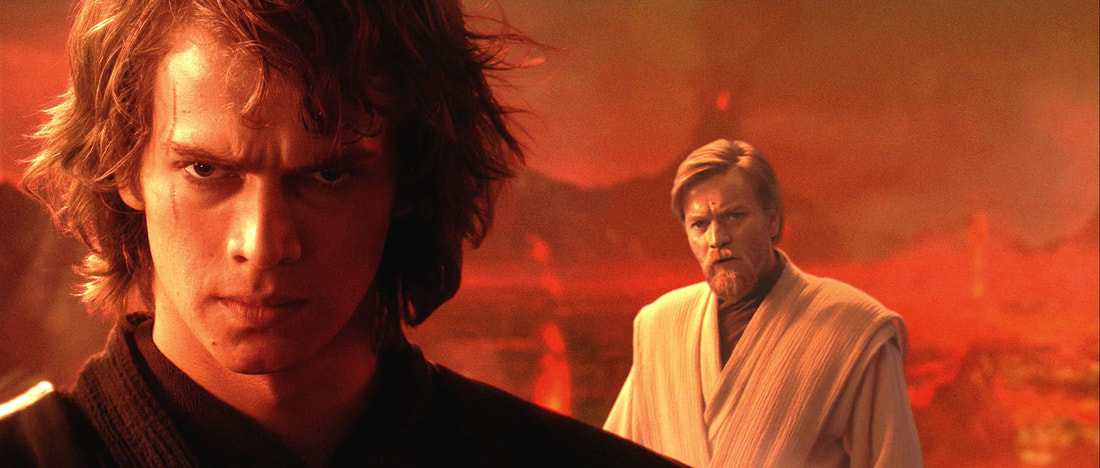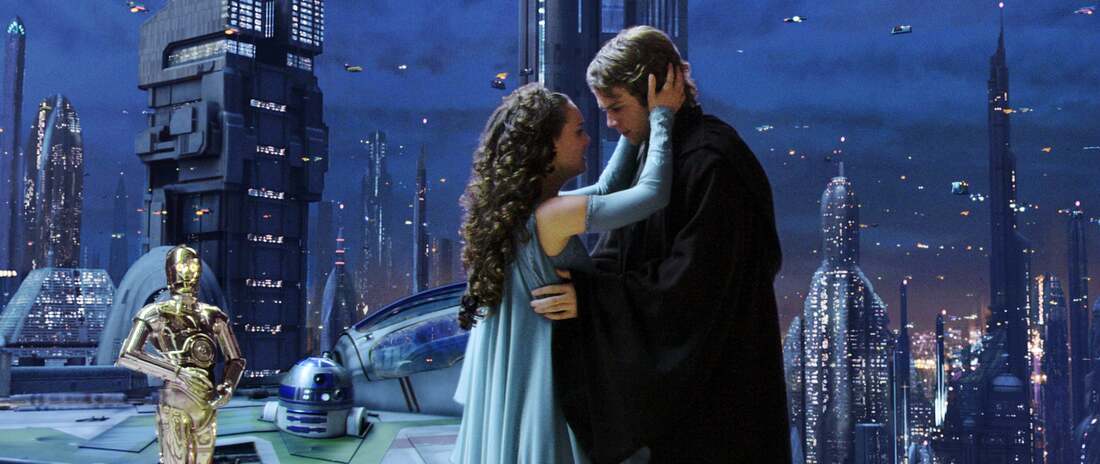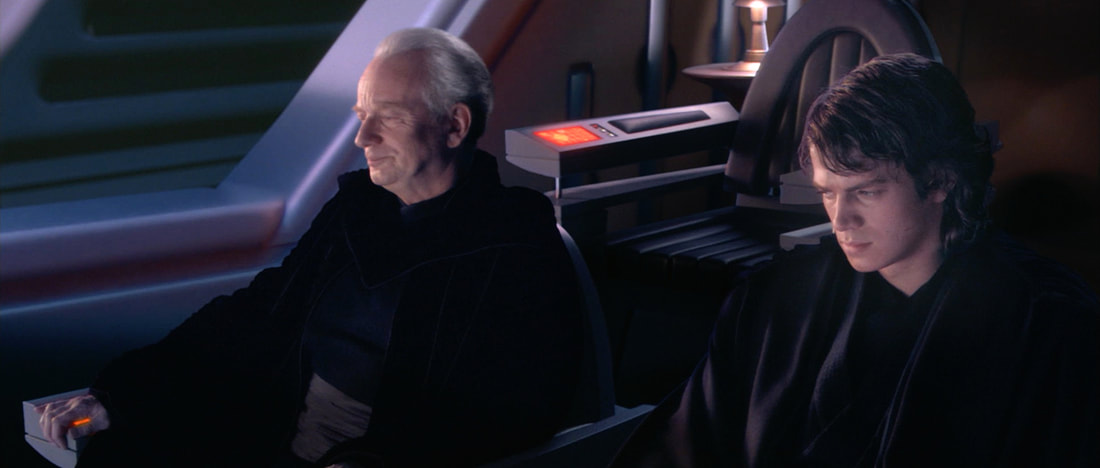Revenge of the Sith tells the final chapter of Anakin Skywalker’s fall from the Light Side of the Jedi Order, and his descent into the Dark Side of the Sith. The transition from hopeful keeper of peace and justice to the deadly warrior of anger and hate is the core of Anakin’s story arc during Episodes I-III of George Lucas’ “Prequel Trilogy.” Anakin does not simply decide one day that he will join Palpatine, the corrupt Chancellor of the Republic and future Emperor, but makes this switch over lengthy periods of paranoia and hopelessness. To understand his transition to evil more fully, viewing the first two films in the Prequel Trilogy can add a lot, however, the third installment is where most of this transition occurs. The events of the previous two films weigh heavily on Anakin and directly influence his actions within part three.
At the start of the film, Anakin and Obi-Wan Kenobi are on a mission to rescue the Chancellor from Count Dooku, a Sith Lord and leader of the military enemy of the Republic, and General Grievous, Dooku’s droid army General. During a lightsaber fight between Anakin and Dooku, the Chancellor convinces Anakin to murder the Count in cold blood, an act no Jedi should ever perform. Palpatine pushes Anakin to leave behind his moral ideology because, “It’s only natural. He cut off your arm, you wanted revenge.” This is the first instance we see Anakin’s emotions used as a tool to turn him into an evil opressor. In fact, as time has gone on, films have become increasingly interested in exploring character psychology, both in the realm of genre films, such as Star Wars or the popular superhero films, as well as in more realistic dramas. This tendency to dive into the head of a character to find the root of their emotional and mental state is one of the staples of Post-9/11 Cinema.
A film such as Zero Dark Thirty (Kathryn Bigelow, 2012) is a great example of this. We see Maya, a CIA agent deal with the stress of finding Osama Bin Laden. In American Sniper (Clint Eastwood, 2014) we watch Chris Kyle deal with the PTSD of being a sniper in the Middle East, having to make tough moral decisions without time to process or think them through, often leading to the deaths of people he does not necessarily want to kill. Though not a real-world example, Revenge of the Sith explores Anakin’s emotions as he exists within an Order that has very strict rules and has lost its way, being generals in a war when they claim to be peacekeepers. It leads to a loss of identity for Anakin, as someone who wants to express love and seek justice for his past pains. He has defied the rules of the Jedi Order by secretly marrying a Senator and the pair finds themselves expecting a child.
Because of Anakin’s uncertainty in the safety of his loved ones, he is susceptible to allowing Palpatine to sway him to the Dark Side and turn the Republic into the Empire. This paranoia reflects that of the American people after 9/11. Because the attack on the World Trade Center and the Pentagon was so unexpected, sudden, and devastating, the American people were immediately angry. In this anger, we went to war in Afghanistan and are still involved to this day. I am not going to choose a side as to whether or not war in the Middle East is a good idea or a bad idea, but there are certainly groups of people who fall on both sides of that line. After nearly two decades, that immediate anger has dissipated to an extent, and those who at one point may have yearned for war and revenge, might now think that the war is unnecessary and that we should not be involved.
Either way, many Americans felt this fear and paranoia that they were no longer safe after such an unprecedented attack on American soil. Because of this, many freedoms were willingly given up. Just look at what General John D. Ashcroft was implying when he stated that preventing terrorist attacks was more important than solving crimes after they had been committed (Liptak). Examine how the US Government used the paranoia of another terrorist attack to justify The Patriot Act as a way of increasing the government's abilities of surveillance of the American people. It would seem Lucas is onto this new facet of American life, one in which the government seeks safety and freedom at the expense of morality and personal freedoms.
Another line drives this comparison between the Dark Side and the paranoia that engulfed America during the Bush presidency after 9/11. When Obi-Wan confronts Anakin in a last-ditch effort to turn Anakin back to the light side, Ankin exchanges dialogue with his old master. “I have brought peace, freedom, justice, and security to my new empire.” A few lines later he says, “If you’re not with me, then you’re my enemy.” This line is nearly impossible to hear and not connect to the famous line by President Bush days after 9/11, “Either you are with us, or you are with the terrorists” (eMedia Mill Works) This line fully shows the government’s response to uncertainty. In essence, if you do not support every action of the government in combatting terrorism, even if it means giving up some of your liberties, you are supporting the enemy. Anakin fully believes this, and the citizens of the galaxy accept Palpatine’s declaration of forming an Empire because it means that they will be safe.
In order to create an Empire that could be used to oppress the masses, Palpatine uses the fear, anger, and paranoia of those beneath him to convince them that their liberties must be given up to make their safety certain. Many in the age of COVID-19 are seeing this same situation play out again. Should citizens follow every single rule set out by the government out of the uncertainty that COVID will affect them or their loved ones? It’s a difficult conversation to have, and one that I do not seek to answer here, however, the fact that these questions that popped up after 9/11 are returning because of the ongoing pandemic has made Revenge of the Sith as relevant now as it was in the years following September 11th.
Works Cited:
Kuek Ser, Kuang Keng. "Data: Hate Crimes against Muslims Increased after 9/11." The World. 12 Sept. 2016. Web. 12 Sept. 2020.
EMedia Mill Works. "Text: President Bush Addresses the Nation." 20 Sept. 2001. Web. 12 Sept. 2020.
Liptak, Adam. "Civil Liberties Today." The New York Times. The New York Times, 07 Sept. 2011. Web. 12 Sept. 2020.




 RSS Feed
RSS Feed
